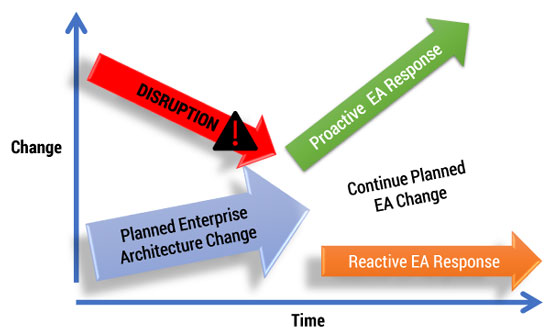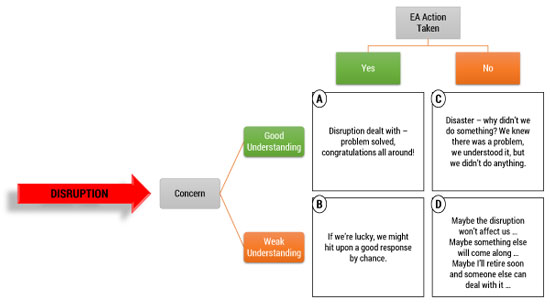Whether we choose to face it or not, digital disruption is here to stay. Whether we choose to accept it or not, digital disruption will affect every enterprise.
Regarding the first of these claims, digital disruption is the transformation that occurs when new digital technologies and business models have a big impact on the value proposition of existing goods and services. The evidence shows that we are constantly being exposed to new digital technologies, and there is a steadily growing range of alternative business models.
The second claim is more open to debate. Some might argue that digital technologies and new business models won’t affect them. In contrast, there is a growing chorus of commentators who suggest a very different future for all of us.
Let’s assume that you have a short-, medium-, and long-term plan for the evolution of your enterprise architecture. Whenever any disruptive force comes along, you have three options (shown in Figure 1):
-
Continue planned EA change. You might choose to continue with your current plan, unchanged, and ignore the possible threats. In other words, you feel that you have already addressed these concerns.
-
Reactive EA response. You might react to the disruption by adopting a temporary fix to address the immediate threats; this is followed by further reactive changes as the situation develops. For example, some brick-and-mortar book retailers responded to Amazon’s digital invasion by reducing their prices. This allowed them to survive for a short time, but it made their business model unsustainable. This response didn’t seriously look at the need to change both the business model and its supporting enterprise architecture, perhaps by including digital distribution and creating a distinctive Internet presence.
-
Proactive EA response. You might really consider the disruptive possibilities outlined in the previous section and act accordingly. For example, a book retailer might choose to concentrate less on growth and more on providing a community hub and meeting place. In the banking world, many financial institutions are struggling to create a new vision for their branches; as customers increasingly switch from visiting a branch office to transacting online, the role of the branch has changed. Perhaps if banks focused less on “selling” products and more on providing much-needed local facilities, it might mean that many branches wouldn’t have to close down. In the UK, for example, a bank branch might become a place to get financial advice, or it could become a coffee shop and/or a post office.

Which option will you choose? At the heart of your decision (apart from any political or resource considerations specific to your organization) is the deeper question: to what extent can we truly architect our futures? Some might argue that as systems and architectures get increasingly complex and intertwined, it becomes harder — or even impossible — to anticipate, predict, plan, and/or manage their evolution.
A Risk Management Approach
There are no “right” answers. My recommendation for addressing this dilemma is based on the ideas of author Greg Craven, who was concerned about one of the six change drivers former US Vice President Al Gore described in his book The Future — global warming. He realized that fighting over the facts about climate change and debating whether there really was cause for concern didn’t matter. Instead, he approached the situation by looking at the risk involved in each of the potential responses to the problem.
In EA terms, Craven recognized that there is a “concern” about global warming — and this concern is real, even if the existence of global warming is still debated. Craven argued that if we act but later realize that global warming wasn’t important, then we will have taken actions we didn’t need to take. Conversely, if we don’t act and global warming is a catastrophic issue, then it might be the end of the planet and our future. Inaction carries the greater risk.
From a risk perspective, the same thing is true of digital disruption — and we need to make sure that we avoid thinking wrongly about it. It may pose a risk to our enterprise, or maybe there is no risk. The best response from the EA team is to examine digital disruption, understand the implications in terms of the components and configuration of the architecture (i.e., translate them into architectural thinking), and present options for responding as potential changes to the architecture. The important thing is to present these options as clearly as possible so that stakeholders can make architecturally informed decisions.
Following Craven’s lead, our EA responses are shown as four options along two axes: understanding and action (see Figure 2). We first ask ourselves, how well do we understand the concerns surrounding the potential digital disruption? Secondly, do we take action or not?
-
Option A: Good understanding, action taken. If we have a good understanding of the issues around digital disruption and we act, then we will likely succeed. This is the ideal response — the concern is understood from an architectural perspective, and we have produced an effective response. The UK book retailer Waterstones responded to the digital threat by encouraging browsing in its stores, which often include a café, and by building a digital presence in addition to its physical locations. The focus remains on its core product — books — but architecturally Waterstones added an equally important online channel along with new services and capabilities.
-
Option B: Weak understanding, action taken. This is the second best choice. Even if our understanding is not so good, we may well be lucky and come up with an effective plan. If we are less lucky, what’s the worst that could happen? It might be that the actions we take are an unmitigated disaster, but this is unlikely. The fact that we acted puts us in a stronger position to deal with digital disruption, and this is particularly so if the EA team is prepared to continue updating their plan based on monitoring its results. The best way to avoid the risk of a bad outcome is to improve our architectural understanding and shift our position to the A quadrant. In any case, Options A and B are both better than C and D. The British retailer WHSmith, unlike Waterstones, took a different response to the digital threat — it introduced a subtle change to the nature of its business by focusing on new outlets in railway stations, airports, hospitals, and motorway service stations. WHSmith recognized the growing demand for books, stationery, magazines, entertainment, and refreshments by people who are traveling. While WHSmith has an online presence, it didn’t choose a direct response in the same way as Waterstones.
-
Option C: Good understanding, no action taken. A good understanding of digital disruption, or any other form of disruption, will show that there is a high risk and that we need to respond. If we have a good understanding of digital disruption but we don’t do anything about it, then we probably deserve the consequences! There are countless examples of book retailers (e.g., Borders, Atlantic Books) that failed to respond to the digital threat of online sellers such as Amazon.
-
Option D: Weak understanding, no action taken. If we don’t have a good understanding of the issues and we don’t do anything, then maybe all it shows is that we don’t really care — we consider other things to be more important.

For an enterprise architect, the key point is to understand digital disruption as well as you can and plan the best possible response given this understanding. As Craven discovered when he studied global warming, it doesn’t really matter whether disruption from digital is likely or not. What matters is that action is always better than inaction.
I passionately believe that EA has produced a set of techniques that can help us see the big picture and produce patterns that will induce positive, emergent behavior in our architectures. We can cast a stone that produces a ripple that washes over everything. Let’s make it a positive force. (If you want to know more about the idea of architectural thinking, I have produced a free online course that explains it.)
[For more from the author on this topic, see “Beyond Disruption: Can We Truly Architect Our Digital Futures?”]


